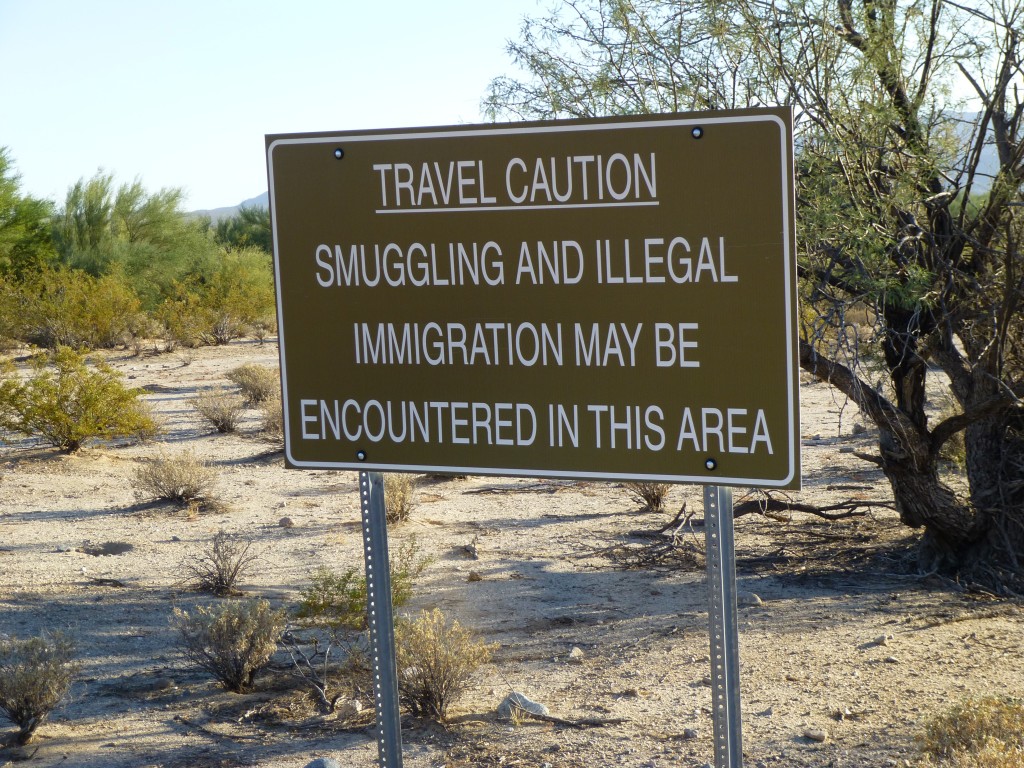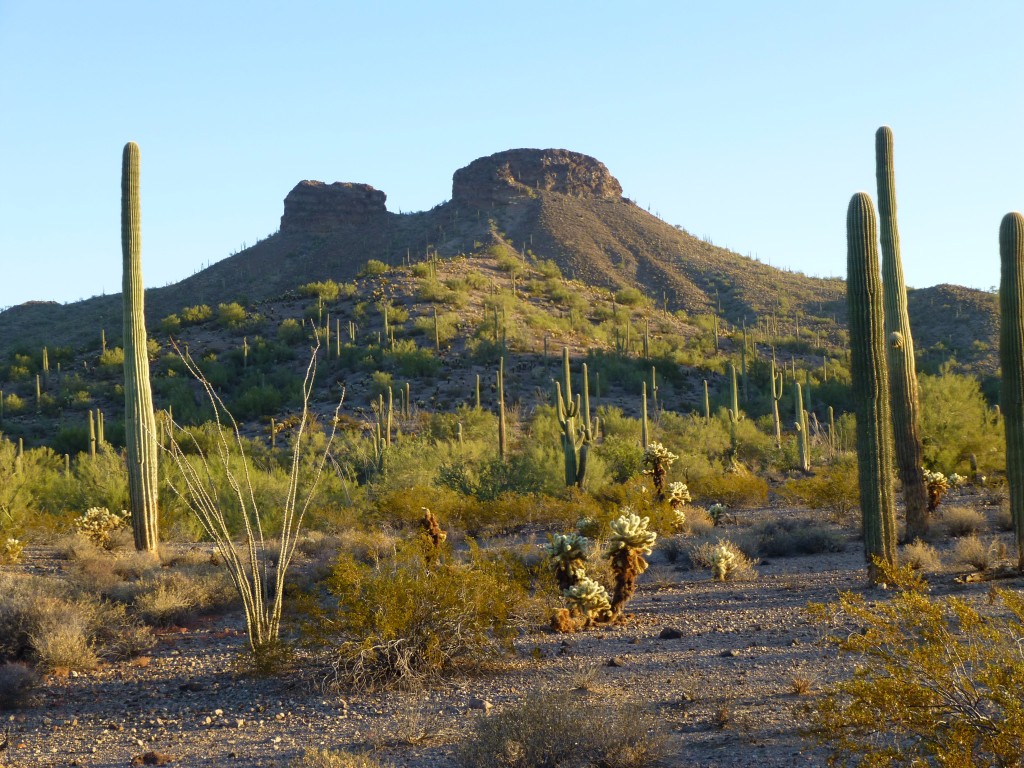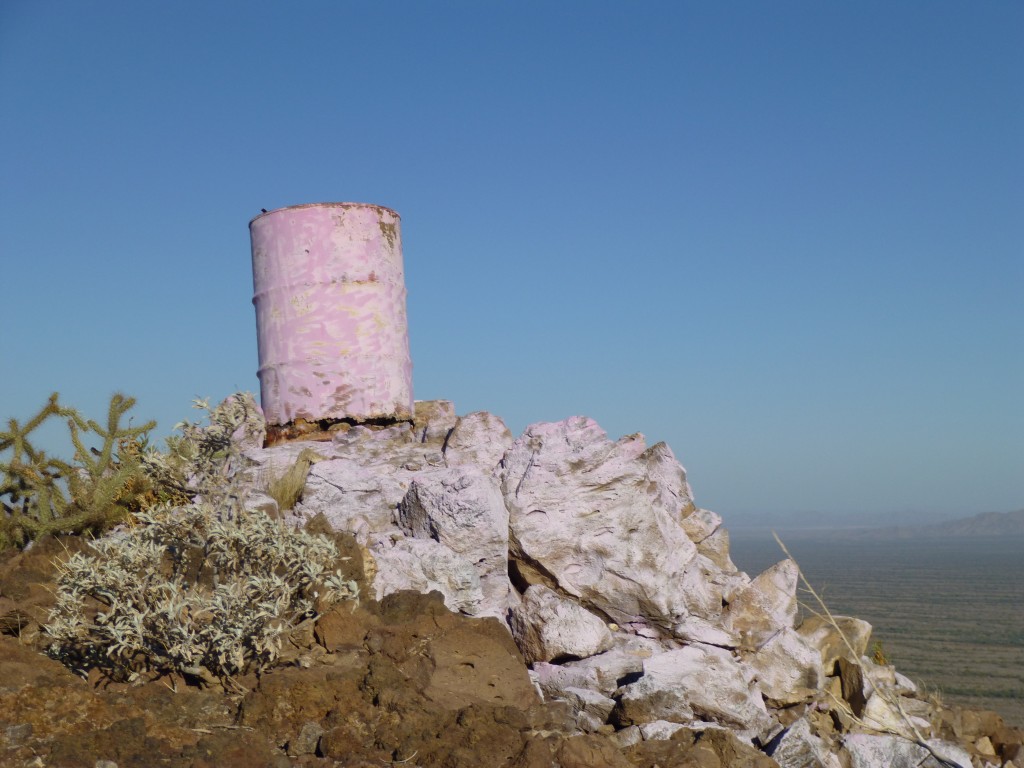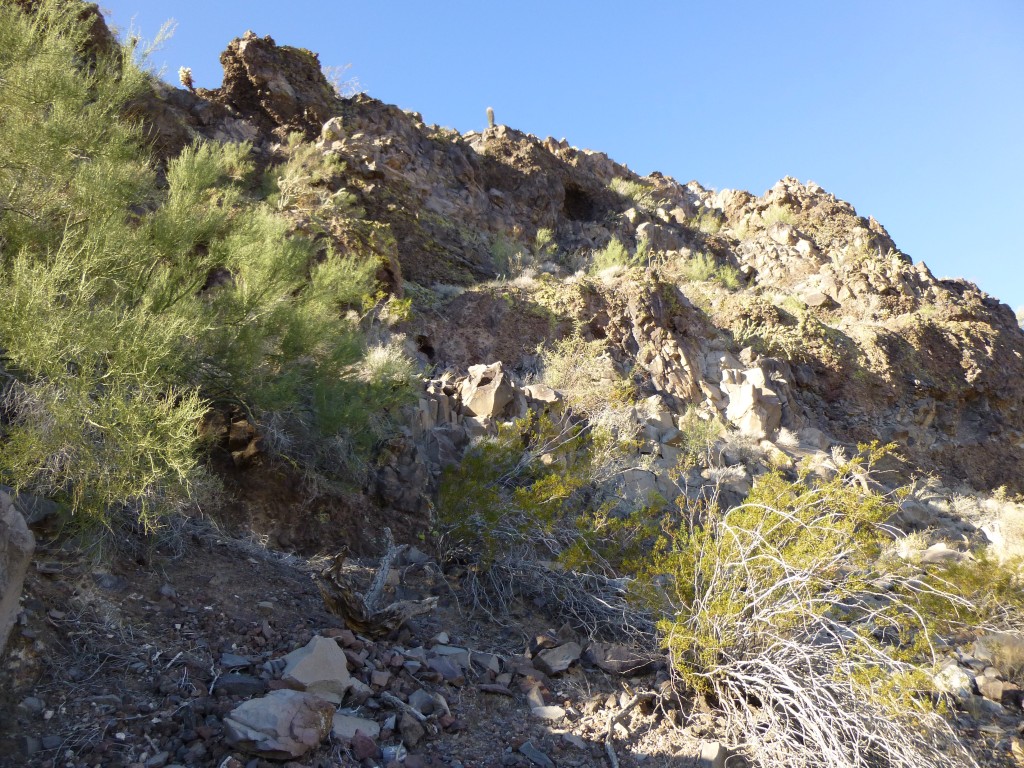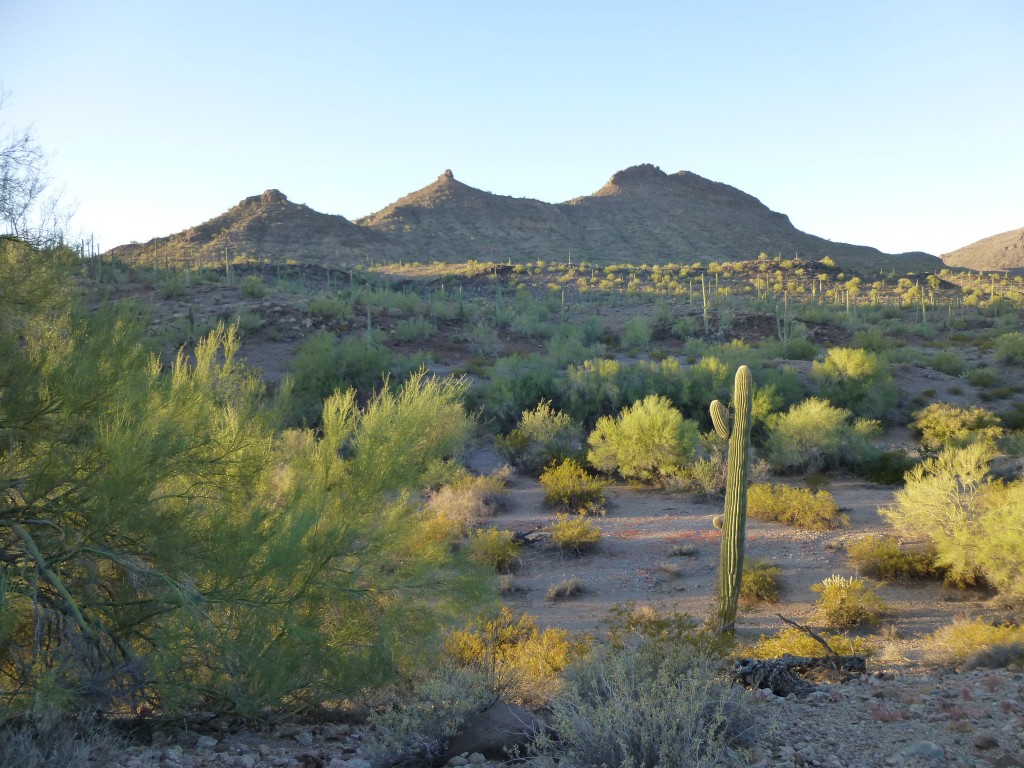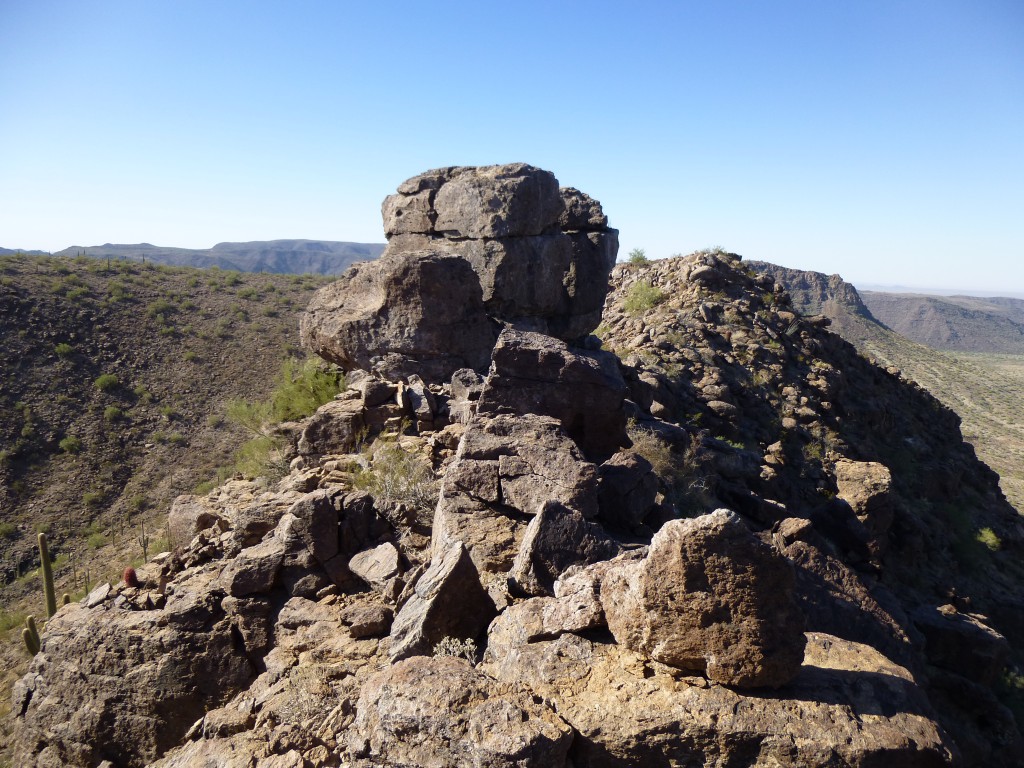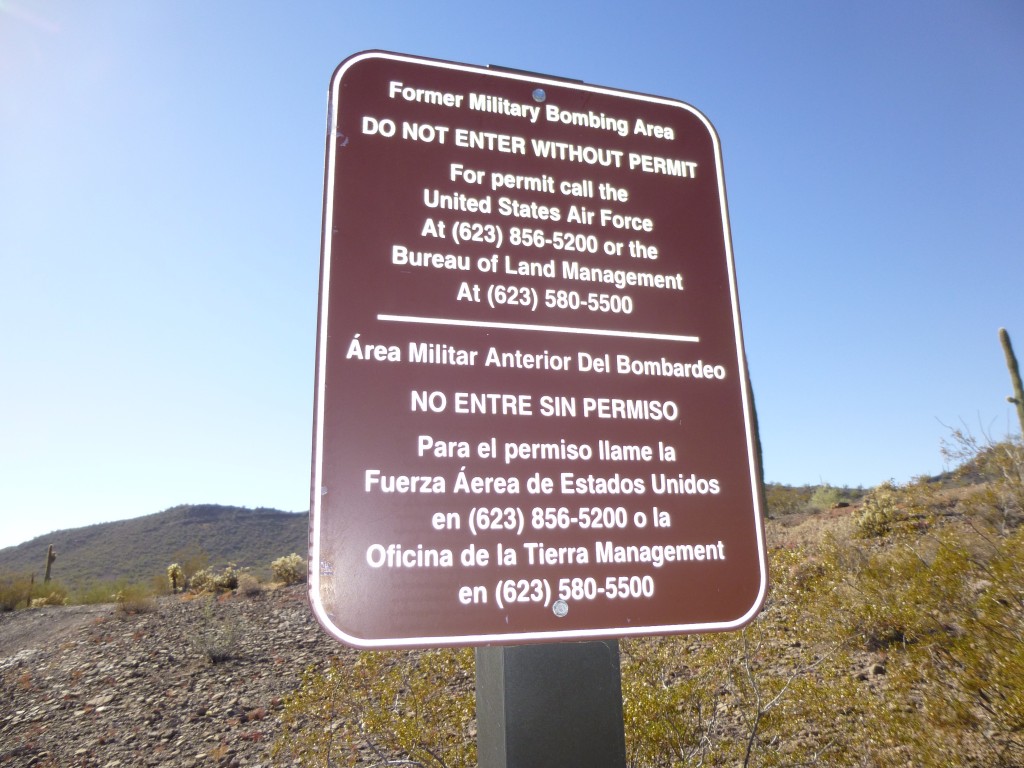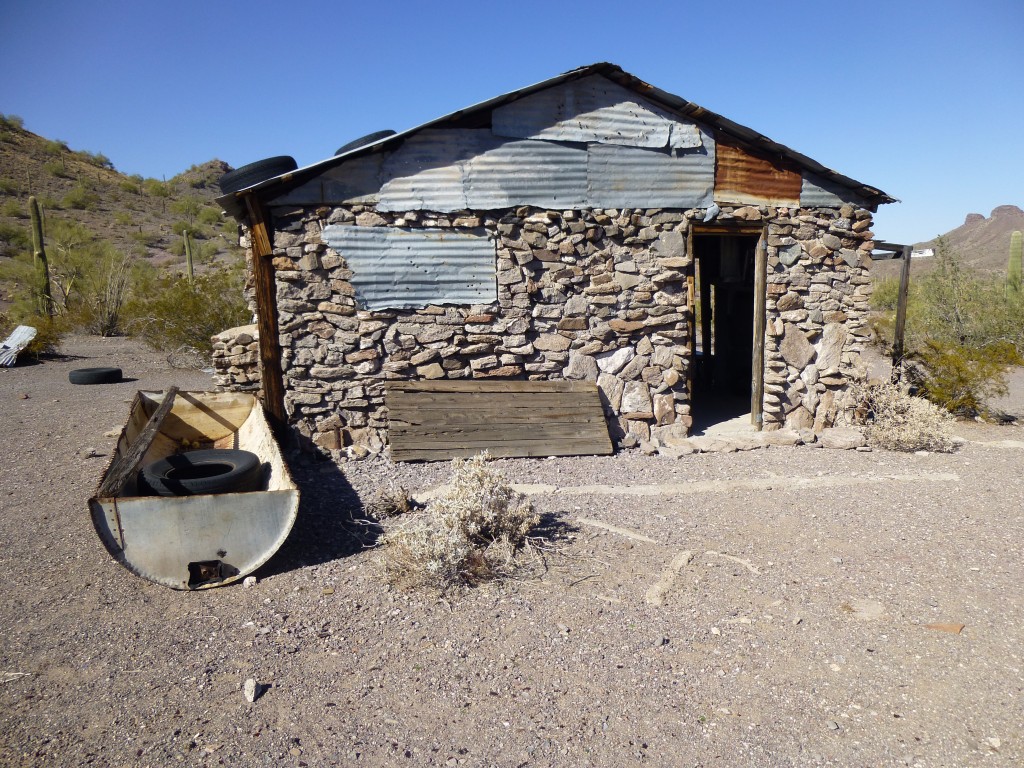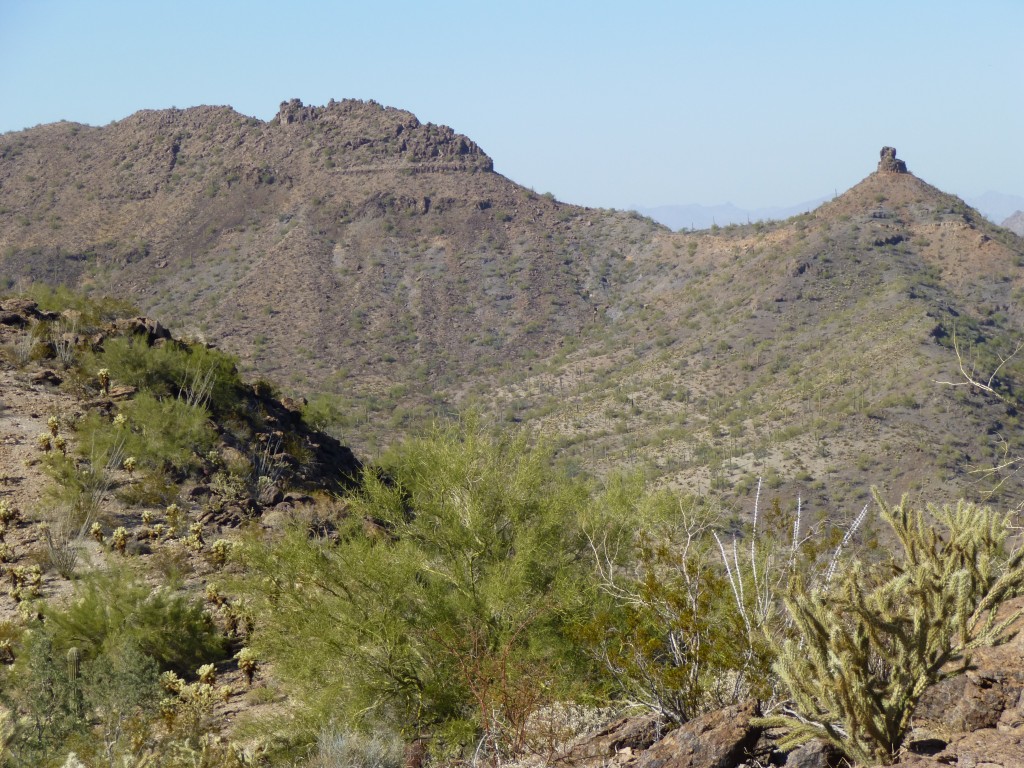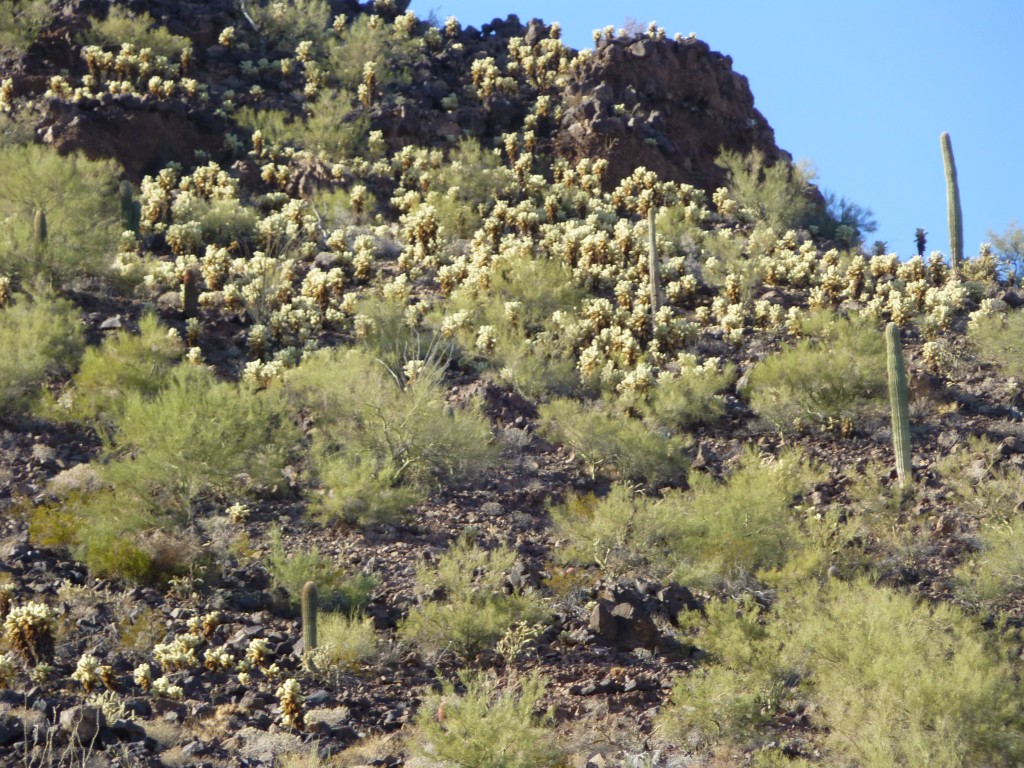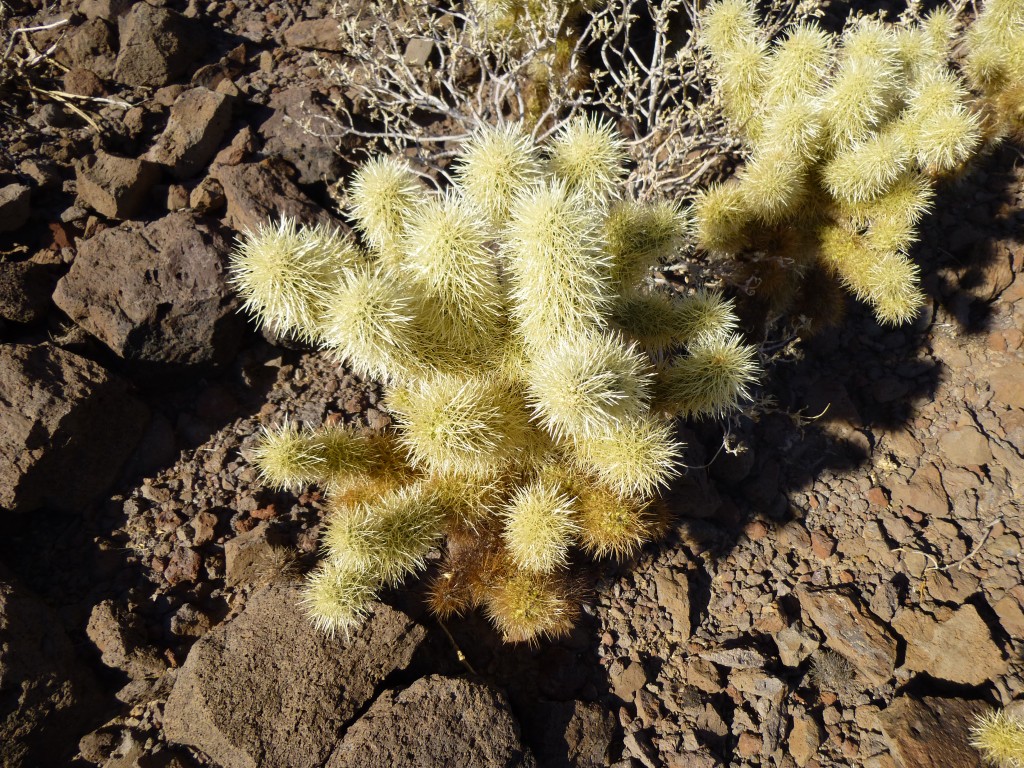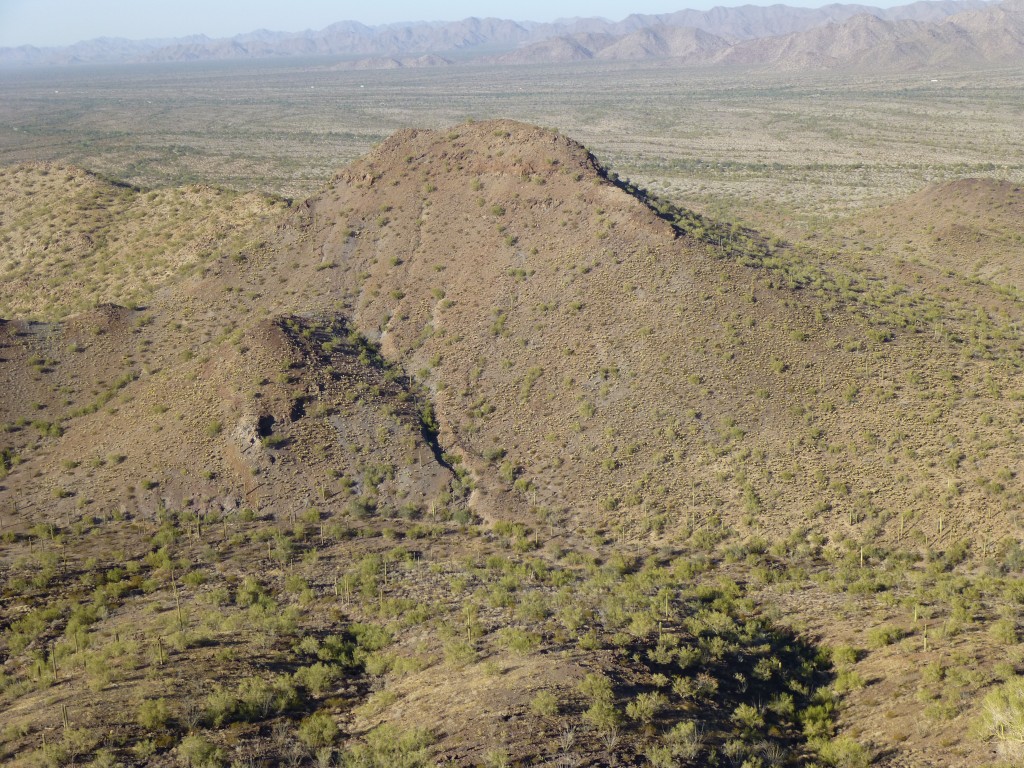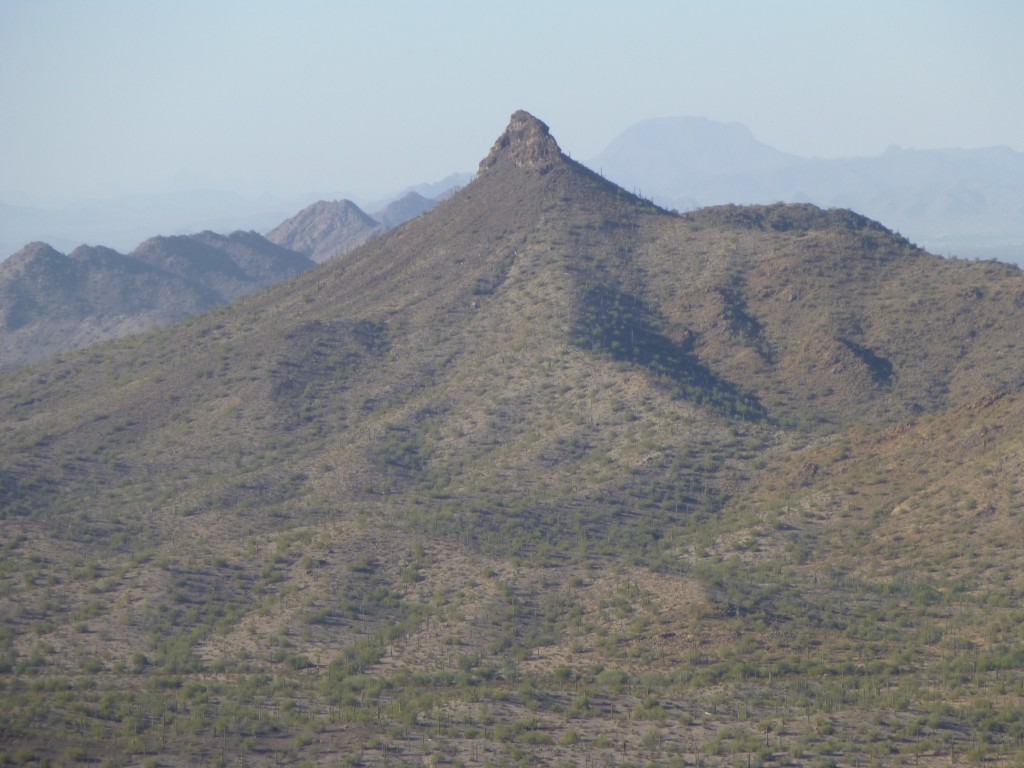Winter has arrived, it’s our bragging weather, and you’ve gotta go out and use every possible day for climbing. And every day’s weather is perfect, so you can’t lose. I was in the mood for something remote and quiet, so, even though it meant 200 miles of driving for the day, it seemed like the Sand Tank Mountains would fill the bill. I got up at oh-dark-thirty and got on the freeway, heading north to Casa Grande and then west on Interstate 8 for 44 more miles. It was still dark when I got off at Big Horn and unlatched the gate. Driving on roads 8011 and 8011A for about six miles, I arrived at a junction with road 8012. I then realized I was only a mile and a half south of the freeway at this point, and if I had tried the gate near Getz well, I would have been a whole lot better off had I come in that way.
I continued south for another two miles and came to another junction, this time with road 8017. The map showed it as a jeep trail, and here in Arizona that usually is a warning that you can expect some especially rough going. It started off well enough, rolling up and down through open country, but went down a steep gritty hill which gave me pause. It was one of those hills that, when you get to it, you get out of the truck and study it, maybe even walk it, to decide if it’s a smart move to drive it. You can drive down just about anything, but can you drive back up it again? I gave it a thumbs up, and down it I went. Now the road was a canyon bottom, very sandy and winding. I was motoring along, minding my own business, when I came to a spot that almost did me in. The ground suddenly sloped steeply down to the right into a deep hole filled with sand. I hit the sloping part at a pretty good clip and felt the whole truck pull over in the deep sand, but thankfully I made it through and shot out the other side without getting stuck. If the truck had veered over into the hole with its deep soft sand, I’d be stuck there for all eternity.
A mile in the sandy wash brought me to the perfect spot for my first peak. Although it was scheduled to be 85 degrees today, it was still pleasantly cool with a nice breeze as I shouldered my pack and set out. My first objective for the day was a double summit called Squaw Tits.
Talk about politically incorrect – both sexist and racist! It’s one of those old place names that should have been changed long ago, but hasn’t been yet. My route took me northeast towards the peak, which stood only a mile away. The intervening ground was easy enough, rising steadily as I went. I kept eyeballing the right (east) peak, the higher of the two, feeling pretty sure I saw a way up, but when I got right up to the final 150 vertical feet, I realized it was tougher than it looked. My first attempt was on the southwest corner, but I soon abandoned that. Circumnavigating the peak in a counter-clockwise direction, I looked for some line of weakness, but found none. Before I knew it, I had gone all the way around to the north side, and was beginning to despair of ever finding a way up.
The best route I saw was not a good one, but I decided to give it a go anyway, as I was running out of options. About twenty feet of near-vertical rock reared above me, but it looked pretty stable. I tentatively tried it and it felt pretty good, so I started up, and soon I was committed. A few more moves, and in less than a minute it was done. Truth be told, I was sweating bullets while it was going on. Some gritty ledges gained me more height and I was thinking I had it made, when I came to another spot much like the first. Damn – I did not have a good feeling about this. This next piece was shorter, maybe fifteen feet, also near-vertical, but once again the rock proved pretty stable, unlike the rotten crud populating most desert peaks. I climbed it, but as soon as I was done I thought to myself “You fool, what were you thinking, taking chances like that? Out here by yourself, unroped, miles from help.” My heart was pounding as I climbed up the easier final stretch to the summit.
The wind was extremely strong on the summit, and I had to be careful where I walked to not get knocked down by it, as there was a lot of exposure in places. Sitting on the top was an empty steel 55-gallon drum that had once been painted a bright pink – it had to have been placed there by a military helicopter.
Nearby was a cairn and inside it a summit register with quite a few entries. I signed in but didn’t linger – quite frankly, I was worried about getting back down. Checking around in a few other places didn’t provide me with any other route off the summit, at least not one that was easier than mine. So, I started down, following the series of rock markers I had left through the tricky bits, and came to the first vertical piece. I looked around for some way, any way, to bypass this but found none. Gotta tell ya, I was worried. Facing in towards the rock, I carefully climbed down, feeling for holds with my feet. I kicked a few loose pieces away, but the rock was otherwise sound. I was so relieved to be down, that, as I continued my descent, I forgot all about the lower tricky bit until I was standing at the top of it. Dang! Oh well, the other one had gone well, so this one should too. It did, but I wasn’t happy doing it.
I breathed a sigh of relief, and headed west. Squaw Tits is a double summit, and I went over to a spot between the two, looking for a quick and easy way up the other one but saw none, so I headed downslope towards the south and my truck. A pleasant mile in the still-cool morning air finished up in a nice canyon, and I was back at my truck. This little adventure had taken just over two hours, but I still had a lot more to do.
I moved my truck to a new spot about half a mile farther west, parked, and set out again, this time heading south, my next objective being Peak 2502. From the desert floor, it was hard to tell exactly where its highest point was, but there seemed to be a series of rocky pinnacles up there and it was one of those.
It was a straightforward climb, and before too long I was on the summit ridge. I started poking around, trying to decide which spot was the highest, and after eliminating a few contenders I decided that this one shown below was it. The summit block was about 20 feet high.
I went over to it and walked around, finding a short route up the good rock. There was a small cairn on top, and a summit register within. Whose names would I find inside it? I was really curious. Turns out the register had been placed back on January 17, 1998 by three serious peakbaggers – Bob Martin, Richard Joseph and Mark Nichols. Nine years later, another climber had signed in – Ted Brasket from Prescott, who had soloed the peak at 77 years of age! It is an inspiration to know climbers such as these who continue to do so much into their 70s and 80s.
I signed in and headed down – the better part of two hours had passed by the time I got back to the truck. All day, I had been fretting about the sand hole, wondering if I could safely drive past it. It didn’t take me long to reach the spot, and I stopped well before the hole. There was an ironwood tree growing across from it, narrowing the space I could drive through. I broke off a bunch of large dead branches to give me more room and then felt I could safely give it a try. The key was this – four-wheel drive, low range, second gear. I gunned it and flew through the gap – the soft sand didn’t suck me in. Yay!! Several more miles of driving took me into a restricted military area – of course, I had the necessary permit.
A few minutes later, I arrived at an old house beside the road – God only knows how long it had sat there abandoned. At the very least, since 1941 when the bombing range was established. When I see an old place like this, I wonder about its history. There was a well nearby, labeled “Mesquite well” on the map.
I spent a few minutes poking around, then headed farther up the road and parked at a saddle. My nerves had settled down from the sandy spot, so I felt I could enjoy my lunch and soak up the beautiful scenery. There was another summit close at hand, Peak 2302, which was in fact the reason I had driven over here. It didn’t take long to reach the summit, where I found another register left by Ted Brasket in 2007. Mine was the only entry after his.
I returned to the truck and drove back out the way I had come in. Miles later, I had driven all the way around to the east side of the range. My goal was to climb two more peaks to finish the day. I parked in a wide sandy wash within the bombing range and set out on foot again. It felt hot, every bit the 85 degrees that was predicted for the day, as I trudged gently uphill in the wash. When I was at the foot of Peak 2441 on its southeast side, I started up through fields of teddy-bear cholla.
On the summit, I poked around and found a register, once again left by Ted. I signed in and looked over to the north, to my final objective for the day, Peak 2260.
Not far to go now to finish the day – all I had to do was drop down 500 feet and start up the last slope. However, it was not to be. I had just begun my descent when I felt the first twinges of a leg cramp, and it felt like it could become a good one. I drank my last quart of electrolyte all at once, but I still felt that if I pushed my luck, I could get into trouble. Discretion is the better part of valor, as they say, so I decided to call it a day. Dropping to the desert floor the easiest way possible, I made my way back to the truck by using my GPS to home in on it, as it was totally hidden in a large area of brush. The shadows were long by the time I got back – wow, an hour and a half had passed. To keep the cramps at bay, I drank every drop I had waiting at the truck.
What a great day, but long – I had started in the dark and finished long after sunset. The Sand Tanks are a great range with, close as I can tell, 62 summits. I have climbed a bunch of them, but many more remain. They are well worth the drive from anywhere, and I can’t wait to return to climb more of them.
UPDATE – good news! As of mid-2021, there has been an official name change. The name “Squaw Tits” has been deleted and the peaks are now officially called the “Isanaklesh Peaks”, a name which reflects the Tohono O’odham people. This area was part of their ancestral home for centuries.

